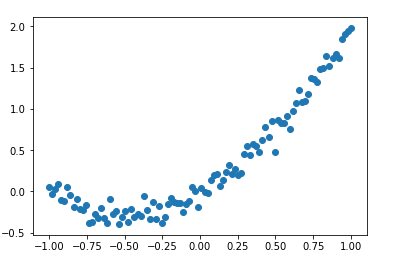这一节使用TF搭建一个简单的神经网络用于回归预测,首先随机生成一组数据
import tensorflow as tf
import numpy as np
import matplotlib.pyplot as plt
tf.set_random_seed(42)
np.random.seed(42)
x = np.linspace(-1,1,100)[:,np.newaxis] #<==>x=x.reshape(100,1)
noise = np.random.normal(0,0.1,size = x.shape)
y=np.power(x,2) + x +noise #y=x^2 + x+噪音
plt.scatter(x,y)
plt.show()
随机生成了一组数据,模型为(y=x^2+x),看一下数据的分布

接下来搭建一个含有一个隐藏层的神经网络,损失选择使用均方差误差
#模型部分
tf_X = tf.placeholder(tf.float32,x.shape) #=>X
tf_y = tf.placeholder(tf.float32,y.shape) #=>y
output = tf.layers.dense(tf_X,10,tf.nn.relu,name="hidden")#隐藏层10个节点
output = tf.layers.dense(output,1,name='output') #1个输出层
#loss = tf.losses.mean_squared_error(tf_y,output)
loss = tf.reduce_mean(tf.sqrt(tf.pow(tf_y-output,2)))
optimizer = tf.train.GradientDescentOptimizer(learning_rate=0.2)
train_op = optimizer.minimize(loss)
其中tf.losses中提供了常用的损失函数实现,也可以自己去实现,开始训练模型
with tf.Session() as sess:
sess.run(tf.global_variables_initializer())
plt.ion()
for step in range(100):
_,err,pred = sess.run([train_op,loss,output],feed_dict={tf_X:x,tf_y:y})
#cla() # Clear axis
#clf() # Clear figure
#close() # Close a figure window
plt.cla()#
plt.scatter(x,y)
plt.plot(x,pred,'r-',lw=5)
plt.text(0.5, 0, 'Loss=%.4f' % err, fontdict={'size': 20, 'color': 'red'})
#plt.show()
plt.ioff()
plt.show()
看一看效果:

note:上面使用了plt.cla方法,这是由于方便看到变化过程,将plot过程写入到了for循环中,为了避免发生意外错误将对象从内存中清空。